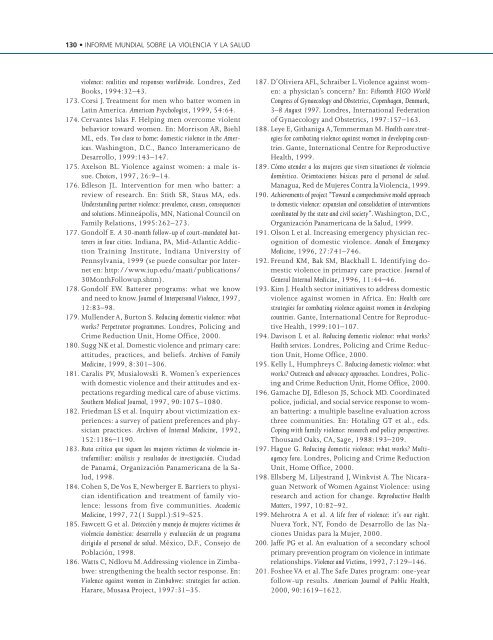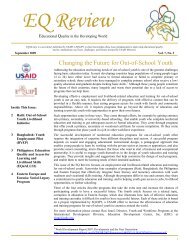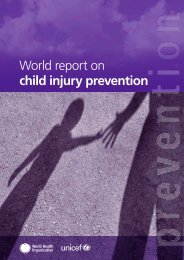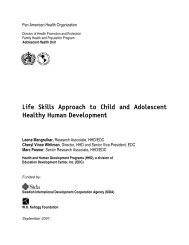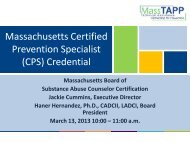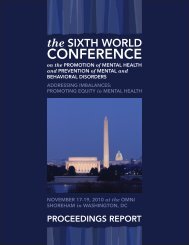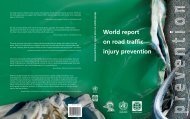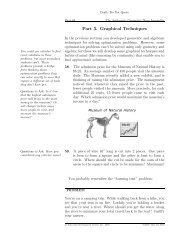Informe mundial sobre la violencia y la salud editado por ... - teach-vip
Informe mundial sobre la violencia y la salud editado por ... - teach-vip
Informe mundial sobre la violencia y la salud editado por ... - teach-vip
Create successful ePaper yourself
Turn your PDF publications into a flip-book with our unique Google optimized e-Paper software.
130 • INFORME MUNDIAL SOBRE LA VIOLENCIA Y LA SALUD<br />
violence: realities and responses worldwide. Londres, Zed<br />
Books, 1994:32–43.<br />
173. Corsi J. Treatment for men who batter women in<br />
Latin America. American Psychologist, 1999, 54:64.<br />
174. Cervantes Is<strong>la</strong>s F. Helping men overcome violent<br />
behavior toward women. En: Morrison AR, Biehl<br />
ML, eds. Too close to home: domestic violence in the Americas.<br />
Washington, D.C., Banco Interamericano de<br />
Desarrollo, 1999:143–147.<br />
175. Axelson BL. Violence against women: a male issue.<br />
Choices, 1997, 26:9–14.<br />
176. Edleson JL. Intervention for men who batter: a<br />
review of research. En: Stith SR, Staus MA, eds.<br />
Understanding partner violence: prevalence, causes, consequences<br />
and solutions. Minneápolis, MN, National Council on<br />
Family Re<strong>la</strong>tions, 1995:262–273.<br />
177. Gondolf E. A 30-month follow-up of court-mandated batterers<br />
in four cities. Indiana, PA, Mid-At<strong>la</strong>ntic Addiction<br />
Training Institute, Indiana University of<br />
Pennsylvania, 1999 (se puede consultar <strong>por</strong> Internet<br />
en: http://www.iup.edu/maati/publications/<br />
30MonthFollowup.shtm).<br />
178. Gondolf EW. Batterer programs: what we know<br />
and need to know. Journal of Interpersonal Violence, 1997,<br />
12:83–98.<br />
179. Mullender A, Burton S. Reducing domestic violence: what<br />
works? Perpetrator programmes. Londres, Policing and<br />
Crime Reduction Unit, Home Office, 2000.<br />
180. Sugg NK et al. Domestic violence and primary care:<br />
attitudes, practices, and beliefs. Archives of Family<br />
Medicine, 1999, 8:301–306.<br />
181. Caralis PV, Musialowski R. Women’s experiences<br />
with domestic violence and their attitudes and expectations<br />
regarding medical care of abuse victims.<br />
Southern Medical Journal, 1997, 90:1075–1080.<br />
182. Friedman LS et al. Inquiry about victimization experiences:<br />
a survey of patient preferences and physician<br />
practices. Archives of Internal Medicine, 1992,<br />
152:1186–1190.<br />
183. Ruta crítica que siguen <strong>la</strong>s mujeres víctimas de <strong>violencia</strong> intrafamiliar:<br />
análisis y resultados de investigación. Ciudad<br />
de Panamá, Organización Panamericana de <strong>la</strong> Salud,<br />
1998.<br />
184. Cohen S, De Vos E, Newberger E. Barriers to physician<br />
identification and treatment of family violence:<br />
lessons from five communities. Academic<br />
Medicine, 1997, 72(1 Suppl.):S19–S25.<br />
185. Fawcett G et al. Detección y manejo de mujeres víctimas de<br />
<strong>violencia</strong> doméstica: desarrollo y evaluación de un programa<br />
dirigido al personal de <strong>salud</strong>. México, D.F., Consejo de<br />
Pob<strong>la</strong>ción, 1998.<br />
186. Watts C, Ndlovu M. Addressing violence in Zimbabwe:<br />
strengthening the health sector response. En:<br />
Violence against women in Zimbabwe: strategies for action.<br />
Harare, Musasa Project, 1997:31–35.<br />
187. D’Oliviera AFL, Schraiber L. Violence against women:<br />
a physician’s concern? En: Fifteenth FIGO World<br />
Congress of Gynaecology and Obstetrics, Copenhagen, Denmark,<br />
3–8 August 1997. Londres, International Federation<br />
of Gynaecology and Obstetrics, 1997:157–163.<br />
188. Leye E, Githaniga A, Temmerman M. Health care strategies<br />
for combating violence against women in developing countries.<br />
Gante, International Centre for Reproductive<br />
Health, 1999.<br />
189. Cómo atender a <strong>la</strong>s mujeres que viven situationes de <strong>violencia</strong><br />
doméstica. Orientaciones básicas para el personal de <strong>salud</strong>.<br />
Managua, Red de Mujeres Contra <strong>la</strong> Violencia, 1999.<br />
190. Achievements of project “Toward a comprehensive model approach<br />
to domestic violence: expansion and consolidation of interventions<br />
coordinated by the state and civil society”. Washington, D.C.,<br />
Organización Panamericana de <strong>la</strong> Salud, 1999.<br />
191. Olson L et al. Increasing emergency physician recognition<br />
of domestic violence. Annals of Emergency<br />
Medicine, 1996, 27:741–746.<br />
192. Freund KM, Bak SM, B<strong>la</strong>ckhall L. Identifying domestic<br />
violence in primary care practice. Journal of<br />
General Internal Medicine, 1996, 11:44–46.<br />
193. Kim J. Health sector initiatives to address domestic<br />
violence against women in Africa. En: Health care<br />
strategies for combating violence against women in developing<br />
countries. Gante, International Centre for Reproductive<br />
Health, 1999:101–107.<br />
194. Davison L et al. Reducing domestic violence: what works?<br />
Health services. Londres, Policing and Crime Reduction<br />
Unit, Home Office, 2000.<br />
195. Kelly L, Humphreys C. Reducing domestic violence: what<br />
works? Outreach and advocacy approaches. Londres, Policing<br />
and Crime Reduction Unit, Home Office, 2000.<br />
196. Gamache DJ, Edleson JS, Schock MD. Coordinated<br />
police, judicial, and social service response to woman<br />
battering: a multiple baseline evaluation across<br />
three communities. En: Hotaling GT et al., eds.<br />
Coping with family violence: research and policy perspectives.<br />
Thousand Oaks, CA, Sage, 1988:193–209.<br />
197. Hague G. Reducing domestic violence: what works? Multiagency<br />
fora. Londres, Policing and Crime Reduction<br />
Unit, Home Office, 2000.<br />
198. Ellsberg M, Liljestrand J, Winkvist A. The Nicaraguan<br />
Network of Women Against Violence: using<br />
research and action for change. Reproductive Health<br />
Matters, 1997, 10:82–92.<br />
199. Mehrotra A et al. A life free of violence: it’s our right.<br />
Nueva York, NY, Fondo de Desarrollo de <strong>la</strong>s Naciones<br />
Unidas para <strong>la</strong> Mujer, 2000.<br />
200. Jaffe PG et al. An evaluation of a secondary school<br />
primary prevention program on violence in intimate<br />
re<strong>la</strong>tionships. Violence and Victims, 1992, 7:129–146.<br />
201. Foshee VA et al. The Safe Dates program: one-year<br />
follow-up results. American Journal of Public Health,<br />
2000, 90:1619–1622.


